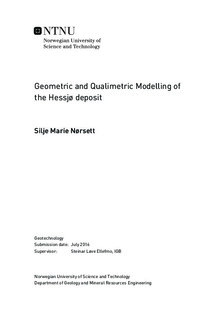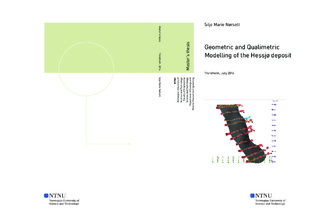| dc.description.abstract | The main goal of this master thesis is to develop geometric and qualimetric 3D-models the Hessjø deposit, located in Holtålen, Norway, using data acquired in the 1970s. This includes a thorough evaluation of the data in terms of quality and applicability to 3D-modelling, a comparison between geostatistics and implicit modelling, in addition to performing a qualitative resource classification of the deposit with regards to drillhole spacing and data quality. The depositional and deformational history of the Hessjø deposit has also been reviewed. The modelling and data evaluation will focus on lens A of the deposit.
The 3D implicit modelling software Leapfrog Geo has been used to generate the geometric and qualimetric models of the deposit. When the geostatistical method of kriging is implemented as an interpolation, it is known as dual kriging, which is comparable to the Fast Radial Basis Functions used in implicit modelling.
Examples of drillhole spacing from feasibility studies that are JORC compliant are presented, together with the primary JORC Code principals.
By reviewing relevant literature, the Hessjø deposit is inferred to be a Cu-Zn-type VMS deposit, of a likely bimodal-mafic subclassification, and shows signs of characteristic zonation patterns inherent to VMS deposits. It is located within the Fundsjø Group, which has been proposed to have been deposited in an immature arc/marginal basin setting. Lens A in the Hessjø deposit has been subjected to deformation and upper greenschist-facies metamorphism.
The data inherent to the Hessjø deposit is partially incomplete, and of questionable quality. Through the evaluation of the data, necessary modifications and assumptions were made, prior to the generation of the geometric model of lens A together with the surrounding geology.
The results from the qualimetric modelling of lens A showed that, when applying various cut-off values, the output volumes of especially zinc, were significantly lowered. The block modelling provided mean grade estimates of copper and zinc at values of 0.92% and 1.19%, respectively, which is significantly lower than the historical estimates.
As the data from the Hessjø deposit is of questionable quality, it is unlikely that it could be classified as anything higher than an Exploration Target or Inferred Resource in terms of the JORC standards and classification scheme. | |

